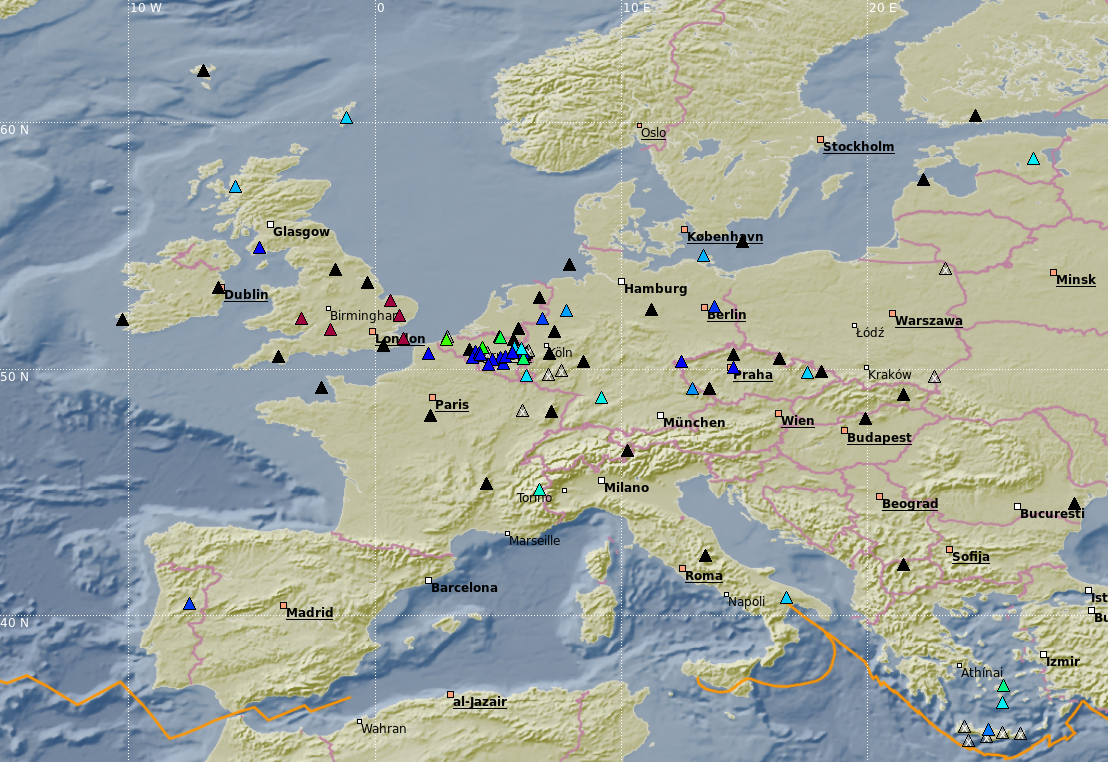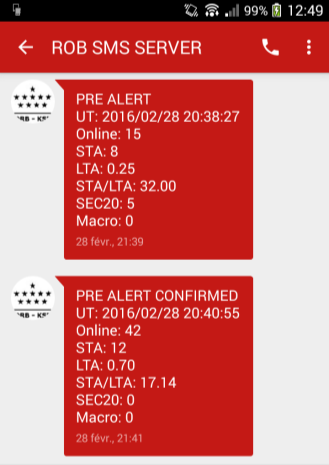The Royal Observatory of Belgium is responsible, as an official mission, to report to the authorities, the media and the public in case of earthquake in Belgium. To provide reliable information that is fast enough to avoid rumours on social media and in the press, the ROB has developed an efficient two-component seismic alert system (Lecocq et al., 2009 [1]).
Over time, the "Alert" system has been given the following names:
- B-FEARS: Belgian Felt Earthquake Alert and Report System;
- BEERS: Belgian Earthquake Emergency Report System, which is the current name.
Part 1: Waveform-based Earthquake(s) Detection
Using the real-time data provided by the Belgian and international permanent seismic networks, the SeisComP3 software is used to automatically detect seismic events, locate them, compute a first magnitude estimate and report everything via email and SMS, all in only a few tens of seconds up to one minute. This detection is possible thanks to the modernization of the seismic network since 1985 (digital acquisition system), the rise of ISDN and later ADSL, and permanent internet connections. The continuous data, streamed in real-time from all permanent stations in Belgium, is recorded on hard disks in our offices at Uccle. Parts of the data are also shared with foreign data centres (IRIS, ORFEUS) or directly with foreign seismic networks. In turn, these centres and networks share data with us, allowing the usage of seismic stations in Germany, The Netherlands, United Kingdom, France and Luxemburg. To avoid the wrong detections and alerts for high frequency teleseismic - very distant - events that can be falsely picked by a local network as a local earthquake, we also included 25 stations worldwide, allowing an accurate detection of earthquakes with a magnitude equal or greater to 6.0.

Part 2: Website-based Earthquake Detection
Whenever an earthquake is felt in our regions, the first reflex of the citizens is to search for information (online nowadays). Because our ROB Seismology.be website is well referenced, visitors rapidly find on our systems. Our Web-based Earthquake detection system is based on an "abnormally"-high amount of visitors when an event occurred: a simple "STA/LTA" computation identifies events. STA (LTA) stand for Short (Long) Term Average. In practice, the amount of new visitors in the last minute is compared to the average number of new visitors per minute during the last hour. Whenever these trigger parameters are met, an alert is sent via email and SMS to the scientists of the ROB. Since 2011, we share our online inquiry with the seismic network of the University of Cologne (Erdbebenstation Bensberg) causing the alert system to be triggered when an earthquake is felt in Nordrhein-Westfalen.

Reporting
The automatic reporting of detected earthquakes is, for the moment, only disseminated internally to the ROB scientists and staff in charge. Whenever an earthquake is detected, it is reviewed by a seismologist in a very short time. When absent from official duty service, this time could be a little longer during the night or weekends, because it requires seismologists to hear their SMS alerts, connect to the ROB servers and process the data in order to issue the information on the official website. Still, in the recent years, the time span between the occurrence of a felt earthquake and its online publication never surpassed 20 minutes.
In & around Belgium
For felt events in (or close to) Belgium, the reporting by ROB seismologists is done in three steps:
- Check the automatic data and confirm an earthquake occurred, add it to the website and open the macroseismic inquiry;
- Call the Crisis Centre of the Ministry of Interior to warn the authorities;
- Process the data and issue a better earthquake location and magnitude, publish updated information on the website and evaluate the impact of the event based on individual macroseismic reports;
- Call again the Crisis Centre to confirm the final parameters.
In parallel to those steps, and depending on the available manpower, we issue Twitter and Facebook messages for the general public and prepare press releases. The Goch event, in 2011, was the first large (ML=4.3) earthquake to trigger the alert in Germany since the beginning of the ROB-BNS shared web inquiry. Like any other felt event, the first macroseismic map of this event appeared on both websites in less than 10 minutes.
Large global events
For larger worldwide events, we provide information to the authorities, the media and the public mainly upon request. In general, we try to prepare and relay some "teachable" content via social media. This includes waveforms recorded by the Belgian Seismic Network or more general information on the tectonic context of the area where the earthquake occurred and the societal impact.
"ROB Earthquake Alert" timeline
- 2002
-
Implementation of a web-based formulaire for felt earthquakes in Belgium,
in 4 languages (French, Dutch, German and English). The forms are
analysed in real-time and provide automatic maps to the Seismology.be
website visitors.
Project by Camelbeeck and Martin (ROB). - 2007-2008
- Onset of the switch of ISDN to ADSL connections, allowing real-time monitoring of the instruments. Work done by Rapagnani (ROB) and the technical support of the ROB.
- 2008
-
Registration of different internet domain names in order to be more
visible on the search engines:
- seismologie.be
- seismology.be
- tremblementdeterre.be
- aardbevingen.be
- 2008-2009
- Participation of Giovanni Rapagnani (Engineer) and Thomas Lecocq (scientist) to 2 meetings on the automatic detection of earthquakes, in Barcelona (Spain) and Erice (Italy).
- 2008
- Installation of SeisComP3, an automatic software for detecting and locating earthquakes based on seismic waveforms acquired in real-time via internet. Automatic detection is sent by email to staff seismologists. Job done by Giovanni Rapagnani (ROB).
- 2008
- In the days following the first two felt earthquakes of Court-Saint-Etienne, Thomas Lecocq developed the Web-based Earthquake Detection algorithm. Based on a simple short-term-average (STA) over long-term-average (LTA) filter on the visitor flux, the system detects abnormal website activity and sends out SMS and emails.
- 2010
- Thomas Lecocq organised the first International Workshop on application of SeisComP3 to monitor local and regional seismic networks. It gathered 20 participants from all over Europe to the ROB.
- 2011
- "EASIMAP: Seismic Risk in Belgium – Fast Mapping of the Impact on Population and Build Heritage" project submitted to "Science for a Sustainable Development" call of Belspo. Partners were Camelbeeck (PI, ROB), Degée (FNRS/ULg), Sabbe (UMons), Hinzen (Cologne, Germany). The project aimed at developing an integrated solution to include seismic and human (intensity) observations to produce impact maps in real-time for the authorities and public planers, allowing them to run scenario earthquakes. The project (999k€) has not been selected.
- 2011
- The Bensberg Erdbeben Station (BNS), the seismic network run by the University of Cologne (Germany) joins our web-inquiry. Until then, citizens feeling an earthquake could submit a formulaire to the BNS website but the data were not analysed in real-time. The Valentine's day 2011 earthquake in Nassau (Germany) was the first event for which the ROB-BNS system created and synchronised macroseismic intensity maps in real-time on the BNS website. Participants to the success are Camelbeeck, Lecocq, Martin, Rapagnani (ROB) and Hinzen, Weber and Fleischer (BNS).
- 2012-2014
- Development of a small and relatively cheap accelerometric station network meant to measure strong ground motions. ROB provided 20000€ (solde reporté) to build 100 stations. The AcceleROB project aims at meshing/covering the entire Belgian territory to measure true ground motions during an earthquake. These measures will then be combined with the ones from the permanent seismic network and with the macroseismic intensities. This project involves Giovanni Rapagnani (R&D, software and equipment design), Baudouin Bukasa (Technical support) and Thomas Lecocq (Scientist) and a lot of volunteers to host the AcceleROBs.
- 2015
- "PINGO: Participatory Initiative for Collecting Geophysical Observations" submitted to the 2016 Axis 6 "Management of the collections" BRAIN-be project "Crowdsourcing". The project aimed at developing a mobile application for collecting various geophysical observables, like rain/snow/hail or thunderstorms. One part of the app was meant to report over felt earthquakes. Partners were Delobbe (PI, KMI) and Lecocq (ROB). The project (325k€) has not been selected despite being ranked fairly high.
- 2015
- The AcceleROB project reached production level and at the end of the year already 30 stations of the 90 planned are installed at individuals, self-installing and volunteers hosting a station. The data acquired is streamed in real-time to the ROB. Stations are built by Bukasa and the technical support of the ROB.
